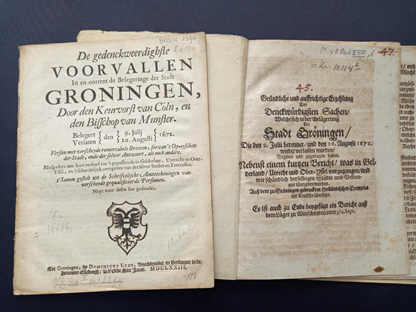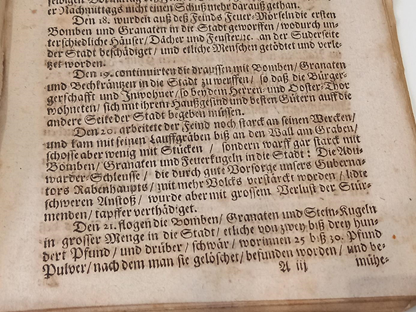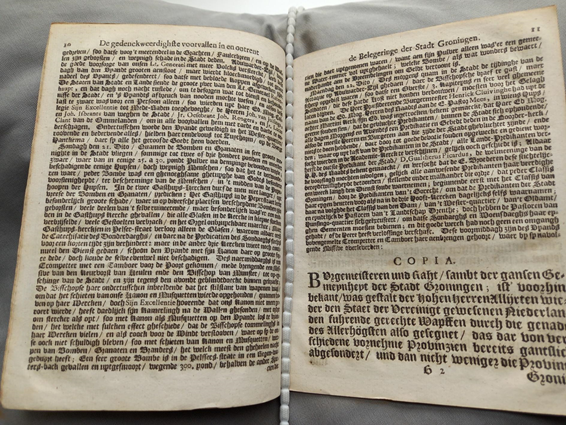Two Sides of One Story

The year is 1673. The siege of the city of Groningen ended a year ago, and the city is slowly but surely repairing the damage caused by the flying bombs and cannonballs of the troops led by the Bishop of Münster. Dominicus Lens, a publisher based in the Kromme Elleboog, has just published a book retelling the story of the siege. Starting on 10 July, one day after the siege begins, and told in diary form, the booklet recounts crucial developments and events. The booklet also contains additional information, including an introduction of the main characters involved, as well as letters, adding up to a total of 36 pages.
Also in 1673, a German version of the same story is published. Unfortunately, we do not know who published this booklet. The general lay-out is comparable to the Dutch version. Just as in Dominicus Lens’ booklet, the story of the siege is told in diary form, but there is one important difference between the two versions. The German version only counts 15 pages, while the Dutch original has 36. What is the reason for this substantial difference?
At first glance, we immediately notice that the 14 letters included in the Dutch version are not included in the German translation. This partially explains the difference in length. However, a closer examination of the content reveals that the Dutch text is also far more detailed that its German counterpart. For example, the events of 21 July 1672 are described as follows in the German translation:
‘Den 21. flogen die Bomben / Granaten und Stein-Kugeln in grosser Menge in die Stadt / etliche von zweij biß dreij hundert Pfund / und drüber / schwär / worinnen 25 biß 30. Pfund Pulver / nach dem man sie gelöschet / befunden worden / und bemühete sich der Feind auffs äusserste / die Kirch zu beschädigen / aber alles umsonst.’

In the Dutch version, on the other hand, this day is described as follows:
‘Sondagh den 21. Dito / Quamen de Bomben en Granaten in seer groote menighte in de Stadt vliegen / sommige tot twee of drie hondert ponden en meerder zwaer / waer van in eenige 25. A 30. pondt Pulver na dempinge bevonden worde; beschadigende eenige Huysen / doch weynigh Menschen / soo dat het de verwonderen waer / yeder Bombe was een ghenoeghsame ghetuyghen van Godts besondere voorzienigheydt / ter bescherming van de Menschen in t midden van de Puynhoopen der Huysen. In de twee Gasthuys-Kercken durfde men niet langer / uyt breese der Bomben en Granaten / predicken: Het Gasthuys in de Peperstraet leedt besonderlich groote Schade / waer in op diversche plaetsen verscheydene Bomben zijn geborsten / veele deelen vant selbe ruineerende / maer besonderlijch was er een midden in de Gasthuys Kercke gevallen / die alle Glasen in de Kercke in kleyne Stucken verbrijzelde / veele Gestoelten verbrack / en het Orgel onbruyckbaer maechte; …’

If we compare these two texts, we immediately see that the German version is much shorter than the Dutch version, but we also observe a difference in content. While the Dutch original lists and describes in detail the damage caused, the translated text does not contain a single detail of the damage. It even states that the ‘vijand’ (‘enemy’) did their best to damage the church, but ‘alle moeite voor niks is geweest’ (‘all their efforts were in vain’). This seems to imply that no damage was caused. The factual statement in the Dutch version that the attack did result in damage to the city has been deleted.
The events of Sunday 21 July are no exception. Throughout the story of the siege in 1672 as recounted in this booklet, the Dutch text describes the developments in great detail, while the German text focuses on the general storyline only. This raises a logical question: What motivated this choice?
Although this question cannot be answered with any historical certainty, we can, of course, speculate. The translation is in German, which implies that even though it was written from a Groningen perspective, it was intended for a German-speaking audience. In view of the fact that the ‘Feind’, the enemy, meaning the bishops of Cologne and Münster (who, incidentally, are not mentioned in the translated text) were of German origin, there may have been deeper political factors and propagandistic objectives at play that influenced the final contents of the translation. All details presenting the city of Groningen as vulnerable were removed, while the aspects of the story that were to the city’s advantage were, on the contrary, emphasized. It looks as if the translation did not contain any falsehoods, but rather that the translator consciously chose to leave out some details in certain places.
The German title starts with the words ‘Gründliche und auffrichtige Erzaehlungen…’, which implies that the story is based in fact. How faithful the author himself was to the facts is a question we cannot answer with any certainty. But what the study of these two texts does teach us is that it is always worthwhile to look at a story from different perspectives.
Sources
Lens, D., Vondel, J. van den, De gedenckweerdighste Voorvallen In en ontrent de Belegeringe der Stadt Groningen, Door den Keurvorst van Cöln, en den Bisschop van Munster. Belegert den 9. Julij Verlaten den 20. Augusti 1672 ... Mitsgaders een kort verhael van 't gepasseerde in Gelderlant, Uytrecht en Over-Yssel ... t'Samen gestelt uyt de Schriftelijcke Aenteeckeningen van verscheyde gequalificeerde Persoonen. Groningen: Dominicus Lens, 1673.
Anoniem, 1673: 45. Gründliche und auffrichtige Erzehlung Der Denckwürdigsten Sachen/ Welche sich in der Belaegerung Der Stadt Groeningen/ Die den 9. Julij berennet/ und den 26. Augusti 1672. wieder verlassen worden/ Begeben und zugetragen haben. Nebenst einem kurzen Bericht/ was in Gelderland/ Utrecht und Ober-Yssel vorgegangen/ und wie schändlich derselbigen Städte und Vestungen übergeben worden. Auß dem zu Groeningen gedruckten Holländischen Exemplar ins Teutsche uebersezet. Es ist auch zu Ende beygefuegt ein Bericht auß dem Laeger zu Winschooten vom 3/13. Sept.
| Last modified: | 17 August 2022 6.00 p.m. |

